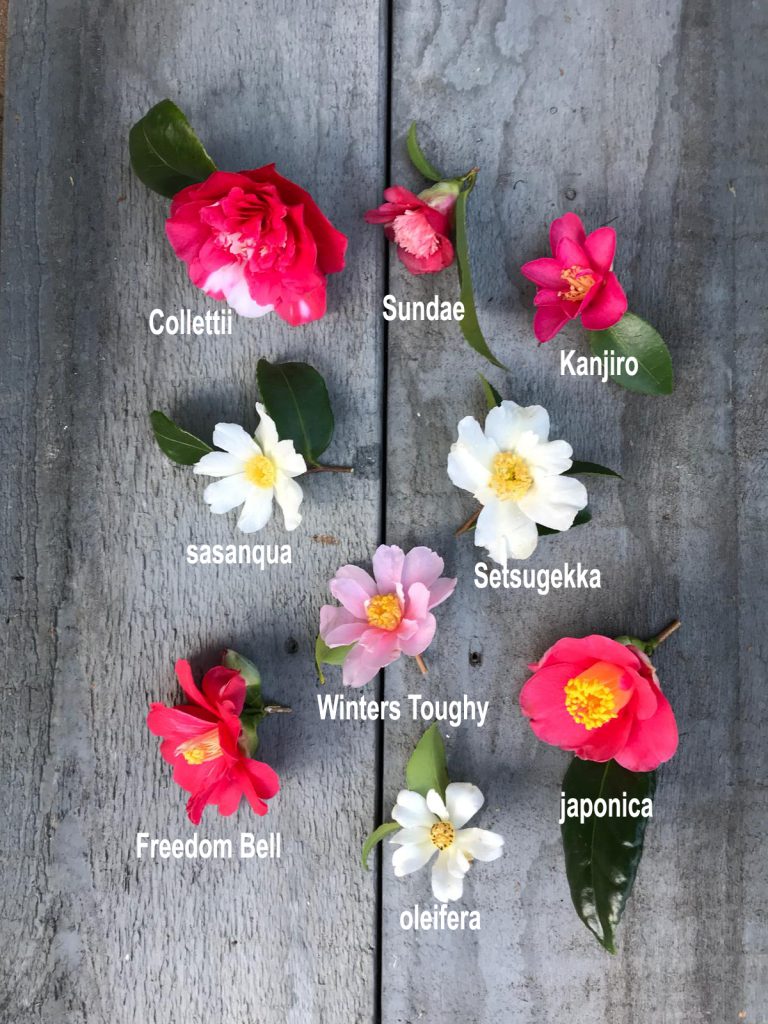If there is a single plant which deserves placing in the limelight again it’s Camellia! For years, Camellia have been incorrectly presented as indoor-plants. If there’s anywhere they don’t like, it’s indoors! Just like Rhododendron, they prefer cool, moist conditions. The reason they have a difficult reputation is because:
– small plants are not yet hardy and so freeze if not adequately protected;
– they are sensitive to their location and must be protected against wind;
– the really hardy varieties are inadequately represented in Holland and are often unnecessarily expensive.
Enjoy the available diversity of Camellia’s

Camellia ‘Kuro Delight’ is very hardy and very red
The diversity of flower type and colours is also inadequately represented in our country. Time for change! Why should we deny ourselfes the richness of flowering that Camellias can offer? Camellias can also be happy planted out. In mild winters they will begin to flower as early as November. The main flowering period is generally a full month to two months before that of Rhododendrons. Our hunger for the first glimpse of colour in early spring can be satisfied! After an average winter most plants flower well, but a severe winter will often damage buds and sometimes branches. This is something we also know from Rhododendrons, so it shouldn’t put us off trying Camellias. In Great Britain, where these marvellous plants are more frequently to be found in gardens than here, occasional frost damage occurs to Camellias too.
Winter hardiness
To my knowledge there are no old collection-gardens here such as are found in England. We have done a lot of testing, since obviously our climate differs from that of England. I have now been working at this for about 25 years. By trial and error I have learnt the main lessons. For example, I know that overwintering Camellias with pot in the soil often gives bad results, even if drainage is good. Also, I know that hardiness estimates from books do not always correlate with my own experiences. In some English books, hardy means ’tolerant of sun and wind’ – something completely different to our interpretation of the word!
Unfortunately Camellias are often incorrectly named, particularly by the general plant trade. There are uncountable identical varieties available under a plethora of different names! Another fact we already know of Rhodo’s:

Camellia japonica ‘Alba Simplex’
every year we get more identical varieties sold under new names! It would be a good thing if somewhere a reference collection were established, but that’s asking a lot of the impoverished botanical gardens in our otherwise rich country, and I don’t expect it to happen.
Camellia culture
Camellias have the same soil requirements as Rhododendrons: pH5-6, with plenty of humus and well-drained. It’s fine to give them a little organic fertiliser in the spring after they have flowered. Make sure of a mulch of straw or equivalent. In the summer it’s important to ensure that the ground doesn’t get too dry, because then the buds will drop off prematurely.
Very hardy Camellias

One of the very best Camellias: Spring Festival
A summary of hardy Camellias is handy; here’s a list of those which survived our extremely severe winter of 1996/97:
Miyako Dori (reached about 175cm – 4.5 feet high without extra protection) with Magnoila-like white flowers
Lavinia Maggi: (about the same height) with full white flowers with pink stripes, without extra protection
Spring Festival: was around 100cm – 40″ high then but is now more than 3 meters (9 feet) high, with small rose form pink flowers. It was protected by fleece blanket at the time, but is actually otherwise in an unprotected position. A highly recommended variety! This species, incidentally, has been reported to be only moderately frost tolerant in the Netherlands. These last plants are situated under and old oak tree, the first against the wall of a shed. I generally use a 15cm deep layer of wood shavings to protect my plants in the winter. More tough varieties are:

Camellia japonica ‘Berenice Boddy’ is very hardy
Adolphe Audusson,
Alba Simplex,
Berenice Boddy,
Black Lace,
Kimberley,
Konronkoku,
Inspiration,
Masayoshi,
Adeyaka,
botanical species Camellia oleifera, Camellia cuspidata, Camellia sasanqua, Camellia saluenensis and Camellia japonica.
But be aware that, fully exposed to strong wind and winter-sun no species is fully hardy!
NEW SPECIES OF CAMELLIA
New Camelia crosses, originating from the United States, where cold fronts sometimes penetrate deep in the Southern States, are offering possible improvements to our assortment. One species, Camellia oleifera ‘Lu Shan’ is able to withstand -24C! I have cuttings of this plant. It is an autumn bloomer with scented cream-white flowers. Also of interest are crosses of this plant with Camellia sasanqua and Camellia japonica: the so called Ackerman hybrids that can be grown with success in continental climates of Europe as cold as USDA zone 6.
Winter camellias

in the Groene Prins Botanical Garden!
OTHER NEW CAMELIAS
Camellia sinensis “Korea”, a very hardy tea-species, develops quickly into broad shrubs. Camellia chekiangoleosa, related to Camellia japonica with a striking orange-coloured flower. It grows vigourously. Camellia edithae has furry leaves and formal pink flowers. We are often asked for yellow Camellias; ‘Brushfields Yellow’ has a creamy-yellow colour, but in open situations the flowers quickly become brown. ‘Dahlonega’ is a much better choice. There are no really hardy Camelias with good, yellow flowers such as Camellia chrysantha.
See our Camellia-assortment ..

